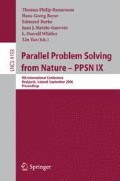Abstract
Evolutionary optimization, among which genetic optimization, is a general framework for optimization. It is known (i) easy to use (ii) robust (iii) derivative-free (iv) unfortunately slow. Recent work [8] in particular show that the convergence rate of some widely used evolution strategies (evolutionary optimization for continuous domains) can not be faster than linear (i.e. the logarithm of the distance to the optimum can not decrease faster than linearly), and that the constant in the linear convergence (i.e. the constant C such that the distance to the optimum after n steps is upper bounded by Cn) unfortunately converges quickly to 1 as the dimension increases to ∞. We here show a very wide generalization of this result: all comparison-based algorithms have such a limitation. Note that our result also concerns methods like the Hooke & Jeeves algorithm, the simplex method, or any direct search method that only compares the values to previously seen values of the fitness. But it does not cover methods that use the value of the fitness (see [5] for cases in which the fitness-values are used), even if these methods do not use gradients. The former results deal with convergence with respect to the number of comparisons performed, and also include a very wide family of algorithms with respect to the number of function-evaluations. However, there is still place for faster convergence rates, for more original algorithms using the full ranking information of the population and not only selections among the population. We prove that, at least in some particular cases, using the full ranking information can improve these lower bounds, and ultimately provide superlinear convergence results.
Access this chapter
Tax calculation will be finalised at checkout
Purchases are for personal use only
Preview
Unable to display preview. Download preview PDF.
References
Auger, A.: Convergence results for (1,λ)-SA-ES using the theory of ϕ-irreducible markov chains. Theoretical Computer Science (in press, 2005)
Auger, A., Jebalia, M., Teytaud, O.: Xse: quasi-random mutations for evolution strategies. In: Proceedings of Evolutionary Algorithms, pages 12 (2005)
Devroye, L., Györfi, L., Lugosi, G.: A probabilistic Theory of Pattern Recognition. Springer, Heidelberg (1997)
Droste, S.: Not all linear functions are equally difficult for the compact genetic algorithm. In: Proc. of the Genetic and Evolutionary Computation COnference (GECCO 2005), pp. 679–686 (2005)
Droste, S., Jansen, T., Wegener, I.: Upper and lower bounds for randomized search heuristics in black-box optimization (2003)
Feller, W.: An introduction to Probability Theory and its Applications. Wiley, Chichester (1968)
Hooke, R., Jeeves, T.A.: Direct search solution of numerical and statistical problems. Journal of the ACM 8, 212–229 (1961)
Jagerskupper, J., Witt, C.: Runtime analysis of a (mu+1)es for the sphere function. Technical report (2005)
Nelder, J., Mead, R.: A simplex method for function minimization. Computer Journal 7, 308–311 (1965)
Rudolph, G.: Convergence rates of evolutionary algorithms for a class of convex objective functions. Control and Cybernetics 26(3), 375–390 (1997)
Teytaud, O., Gelly, S., Mary, J.: On the ultimate convergence rates for isotropic algorithms and the best choices among various forms of isotropy, ppsn (2006)
Author information
Authors and Affiliations
Editor information
Editors and Affiliations
Rights and permissions
Copyright information
© 2006 Springer-Verlag Berlin Heidelberg
About this paper
Cite this paper
Teytaud, O., Gelly, S. (2006). General Lower Bounds for Evolutionary Algorithms. In: Runarsson, T.P., Beyer, HG., Burke, E., Merelo-Guervós, J.J., Whitley, L.D., Yao, X. (eds) Parallel Problem Solving from Nature - PPSN IX. PPSN 2006. Lecture Notes in Computer Science, vol 4193. Springer, Berlin, Heidelberg. https://doi.org/10.1007/11844297_3
Download citation
DOI: https://doi.org/10.1007/11844297_3
Publisher Name: Springer, Berlin, Heidelberg
Print ISBN: 978-3-540-38990-3
Online ISBN: 978-3-540-38991-0
eBook Packages: Computer ScienceComputer Science (R0)

